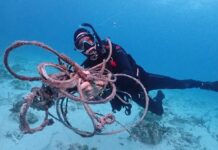The Keys Weekly newspaper has identified two homes that are currently being rebuilt in Monroe County under the Rebuild Florida Housing Repair and Replacement Program. The program, announced in late September 2018 — a year after Hurricane Irma hit the Keys — is designed to rebuild or replace single family and rental housing for families affected by the storm. With funds from the U.S. Department of Housing and Urban Development, $50 million was set aside specifically to be spent in the Keys.
The work on the two homes is valued at $50,000 for the home on Big Pine Key (unincorporated Monroe County) and another $40,000 for a home in Marathon. In the two years the Rebuild Florida program has been in existence in the Keys, it has spent 0.18% of its allotted funds on actual construction — or 18 cents for every $100.
Yet the data provided by the state Department of Economic Opportunity — which oversees the disbursement of funds to the contractor, essentially acting as the “middleman” — does not match records in Monroe County or the City of Marathon’s permitting system. The DEO says there are two homes under construction and one that is complete.
Here’s what we do know. The aforementioned Big Pine Key project consisted of two permits. The homeowner, Deborah Sola, said the work is done on both but she is awaiting a final inspection. The state notes that this project is under construction.
DEO has marked another Keys project of Rebuild Florida as complete and this is partially true. Like the other, this Marathon residence project consists of two permits. The first, to repair ceilings and a closet, is done. The second half of the project, to replace windows and doors, is underway.
“The workers are at my house right now,” said the Marathon homeowner, who declined to be identified by name, on Sept. 15.
City of Marathon officials were unaware this was a Rebuild Florida project. According to them, neither their own rules nor state rules require builders to identify the program. Monroe County, on the other hand, has asked contractors working on Rebuild Florida projects to note it on the permit.
“That way, we can classify the permit as affordable housing and expedite it,” said Monroe County’s Christine Hurley, assistant county administrator.
Monroe County told the Keys Weekly there are currently five Rebuild Florida projects in its system.
Aside from the Solas’ house, Monroe County shows two other residences with active Rebuild Florida permits, although they have not been issued. Those are listed on a DEO report to the county dated Aug. 31. However, the county has two other permits, where the builder self-identified Rebuild Florida funds, which are not on the DEO report.
Monroe County, City of Marathon and the DEO are all using different permit or application numbers to identify Rebuild Florida projects. When the Keys Weekly began asking questions two weeks ago about the program, Monroe County could only identify three residences, now five, in the permitting process. The City of Marathon could identify zero, now one.
Monroe County Mayor Heather Carruthers said the Rebuild Florida program needs to be streamlined.
“It needs to be easier to access. Only one project in unincorporated Monroe County in three years? There’s too much red tape and not enough consistency in the management of accounts,” Carruthers said.
Rebuild Florida has staffed an office in the Marathon Government Center since late September 2018. The Keys Weekly has asked for the state to detail the number of employees and the salaries they earn. In reply, a DEO spokesperson said the department has a “fulltime liaison dedicated to Monroe County,” and sent the newspaper an organizational chart for the department. Salaries earned by state employees are a matter of public record. It’s likely the state has spent more on staffer liaison salary or salaries in two years than it has on the two projects currently under construction.
Carruthers said, “Rebuild Florida has never had consistent staffing down here. The staff changes and homeowners have to come in and tell their story all over again.”
The homeowner’s experience
That’s exactly what happened to the Solas on Big Pine Key, where the work has been completed.
The husband and wife applied for the Rebuild program as soon as it was announced. And then they applied again.
“(DEO) lost all my paperwork and I had to resubmit everything,” she said. According to Sola, the scope of the work included new windows and doors and interior ceiling.
“I feel guilty,” she said, of being the only completed project in the Keys. “There are still so many people who are waiting to have work done, or enough work done.”
The state submitted the Solas’ first permits to Monroe County in late 2019, and the permit was issued a few months later. In June of 2020, the state applied to Monroe County for a new air conditioning system for the Solas, and it was issued a month later. The Solas said the work is complete and the house is cool, but they are awaiting a final inspection on the new HVAC system.
Ron Furtaw owns an Irma-damaged home on Big Pine Key, too. The DEO submitted a permit to Monroe County for work on his home in February 2020. It hasn’t been issued yet, but the scope of the work has definitely changed.
Initially, a consultant identified about $50,000 worth of work to be done at Furtaw’s house. But as the inspector found more issues, Furtaw said that now Rebuild Florida has promised him a totally new house. According to the permit application that will cost about $91,000. Although Furtaw did some work himself before he joined the Rebuild Florida program, he has since stopped, so as to meet the criteria of Rebuild Florida. He has windows, but they’re not impact windows. And most of the drywall was replaced beforehand, as well. But his living situation isn’t ideal.
“I have power problems so I have extension cords running all over from the sockets that do work,” he said. “I like the Keys, I like the weather, but this situation is getting a little old. Of course, I can’t complain too much if I’m going to get a new house.”
The Marathon homeowner also applied for Rebuild Florida as soon as the Rebuild Florida project was announced, on the advice of her Compass 82 advocate (a counseling service that referred Keys residents to recovery resources).
DEO’s summary
The Keys Weekly reached out to DEO for a summary of Rebuild Florida’s efforts in the Keys. According to the report dated Aug. 31, about 1,500 homeowners in the Keys applied to the Rebuild Florida program, but 600 later withdrew.
Of the 900 residents with standing registrations, 465 have completed applications, but 122 then withdrew their application.
That leaves 343 homeowners with Irma damages with a “live” application. Of those, 62 applicants have an “award,” essentially a promise of work. The total is $8.6 million. Of the 62, DEO says 17 of these projects — almost equally divided between single family homes and modular replacements — are in “pre-construction” but none of these has reached the permitting stages in Monroe County or, to the Keys Weekly’s knowledge, any of the other municipalities.
The DEO noted that in almost every instance, the 17 homes are awaiting back-ordered windows and doors; the wait time, according to the documents, is three months. An industry professional with no connection to the state program confirmed the wait, and said homeowners are waiting more like four months for new impact windows and doors.
“The Rebuild Florida Housing Repair and Replacement Program is voluntary and homeowners may choose to withdraw at any point before signing a Homeowner Grant Agreement,” a DEO spokesperson said. “Homeowners may choose to withdraw for a variety of reasons such as obtaining funding from another source, no longer owning the property, or the repairs have already been completed.”
Builders on the ground
Just as homeowners have to apply for the Rebuild program, so do construction companies. Contractors must be vetted in order to participate and the DEO says 18 have been approved to work in Monroe County. And, yet, only two contractors — Ducky Recovery LLC and Lamar Contractors — have projects in the county’s pipeline. DEO says 25 of the 62 projects have been assigned to contractors. Earlier this year, DEO conducted an “invitation to bid” to increase the number of contractors approved to work on Rebuild Florida projects and implemented a new bundling procedure for projects, meant to increase efficiency.
The project in Marathon was awarded to USAC International, which subcontracted to Centro Campesino.
Danny McKearan has worked with Ducky Johnson Construction for more than a decade. The Louisiana-based company began after Hurricane Katrina, mainly providing specialized service of elevating homes. He said the firm specializes in disaster recovery and is no stranger to programs like Rebuild Florida that are powered with federal funding. McKearan said the bigger “the book” — or rules — the longer it takes.
“This is a systemic problem; it’s not just Florida or Rebuild Florida. I would say the wait between the announcement of the federal funding and the start of the program is about 2.5 years, except maybe for Hurricane Sandy.”
Indeed, a document produced by the Florida Housing Finance Corporation said the window between the announcement of a program like Rebuild Florida and its start is typically about 20 to 24 months.
McKearan’s company completed the one Rebuild Florida project in Monroe County, the Solas’ home, and is also listed as the contractor of record for future reconstruction of the Furtaw home. He said he’s also worked on, and completed, more than a dozen Rebuild Florida projects on the mainland. Construction projects take the same amount of time to build, he said, on the mainland and in the Keys. The only difference is the lead up to when construction can start.
DEO said there is no lack of builders in the Keys.
“The reason there are not currently more projects with contractors in Monroe County is not because contractors have not accepted them, but rather because the projects have not yet reached the step when they would be assigned to contractors,” a spokesperson replied to emailed questions.
What’s happening statewide?
Earlier in 2020, Ken Lawson, the head of the state’s Department of Economic Opportunity was removed from oversight of Florida’s unemployment benefits, also managed through DEO, but continued management of the other divisions. He was replaced by Jonathon Satter of the Department of Management Services to overhaul the beleaguered unemployment system. Then, at the end of August, Lawson announced his resignation. Florida Governor Ron DeSantis has installed 37-year-old Dane Eagle, a former state representative from Lee County, in his place.
Lawson was famous for junkets around the Keys where he patted his front pocket and promised, “I got your money right here,” referring to the federal HUD funds that would be used for Rebuild Florida.
While there are only two projects currently under construction in Monroe County, other parts of the state that are farther from Hurricane Irma’s most concentrated damage are faring far better. Brevard County (Melbourne and Cocoa Beach) has the most completed Rebuild Florida projects with 32. A statewide press release identified the completion of the first Rebuild Florida Project in Palm Bay, located in Brevard County in May 2019. Duval County (Jacksonville) has 23 and Polk County (Lakeland) has 20 completed projects. The DEO has reported that statewide, 2,100 homeowners have received an “award” (or promise of work) and the projected work totals $83 million. Statewide, 162 projects have been completed.
The way forward
Builder Danny McKearan says he is not going to give up hope.
“The sentiment from DEO is that they recognized Monroe County as a priority. I mean that honestly; it’s not a throwaway statement,” he said, adding he, too, is curious why Rebuild Florida isn’t flourishing in the Florida Keys.
“I want to see it move forward. Personally, I have made a big investment in Monroe County.
“The time frame between the storm hitting and now and the amount of work being done in Monroe County … well, the time frame is not good, but it’s not abnormal,” McKearan said.
The two homeowners who have had Rebuild Florida-powered repairs made, or being made, at their homes are equal parts grateful and wrung out by the experience.
“They did a wonderful thing for us,” Sola said, while cautioning others to document every step. “They wanted to know the last time I sneezed. That’s a joke. But seriously, save all your paperwork and all your receipts.”
“DEO is committed to working with Monroe County officials to find solutions to the unique challenges of construction in the Florida Keys, including residential Rate of Growth Ordinance, significant elevation requirements and other issues unique to the Florida Keys,” the DEO spokesperson said in an email. “DEO works in close coordination with Monroe County to address these challenges (and) has regular calls with county officials.”
The DEO has not replied to one more question from the Keys Weekly: will Rebuild Florida “sunset?” That is, does the program have a deadline where unspent monies will disappear?
























